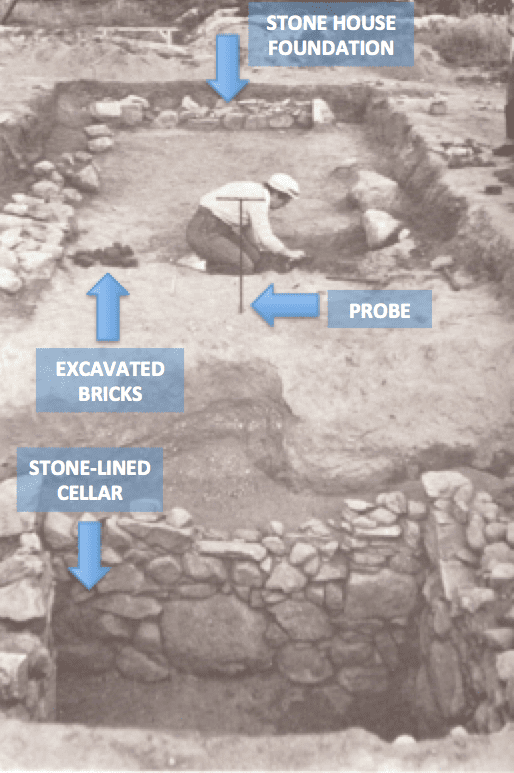Archaeology at the First Site
Archaeologist Roland Robbins and his team excavated the First Site in 1960. They uncovered a long, rectangular house foundation with a stone-lined cellar hole at one end. Many types of artifacts were found, including pieces of ceramic vessels, nails, window glass, utensils, and metal objects. Some of the latter could be related to John Alden’s coopering work. The team also found Native American artifacts which attest to the site’s long history

This picture was taken in 1960 during Roland Robbins’s original excavation of the First Home Site. An excavator is shown using a trowel to investigate stratigraphy, or changes of soil layers, and uncover artifacts within an open unit. The probe in the middle of the photo was used to help find the stone foundation buried in the ground. Today, archaeologists can utilize ground-penetrating radar instead to find buried features.
Many historians and archaeologists analyzed the First Site after Robbins’s excavations. Their findings answered multiple questions about the First Home and, more broadly, about early colonial life within Massachusetts.
The first was how long the Aldens lived at the First Site. Archaeologists can use the known manufacturing date of artifacts to date a site. The vast majority of the artifacts recovered at the First Site are from the 17th-century. This contrasts with the 18th-century objects found at the standing Alden Home. This is one of several lines of evidence that lead scholars to believe that it was John and Priscilla’s children and grandchildren who first lived there.
The second question was about daily life at the First Home. In 2017 and 2018, Caroline Gardiner, Grace Bello, and Elizabeth Tarulis, Historical Archaeology graduate students at the University of Massachusetts Boston, wrote theses about various aspects of the First Site including its ceramic vessels and architectural layout. Their findings give insight as to what activities the Alden family was doing on a daily basis and where in and around their house they were performing them. Their work also offers potential architectural layouts for the site. With future analysis, archaeologists may one day know what the First Site house looked like when the Aldens lived there.
In addition, archaeologists are beginning to compare the Alden collections with those of other early colonial sites within Massachusetts. This comparative analysis will provide insight on how these families related to one another as they sought to establish their new lives, perhaps even revealing individual tastes and relative status within the colony.
For a comprehensive list of written works that address the First Site see the Additional Resources tab.

